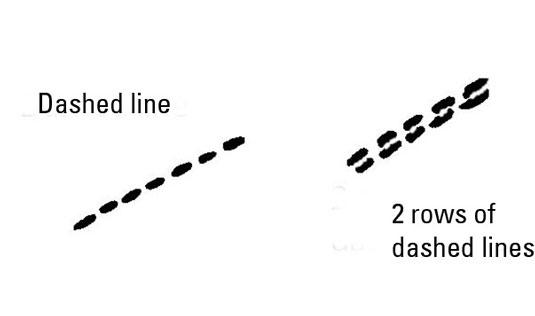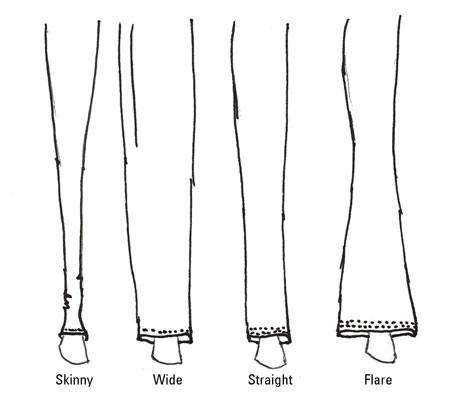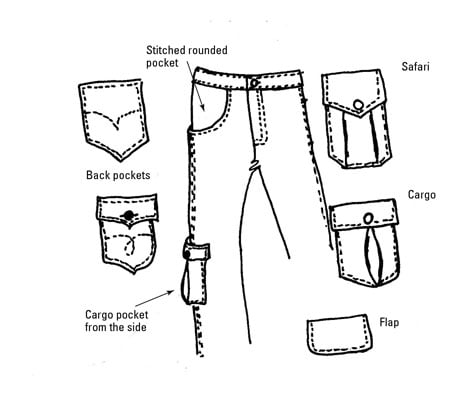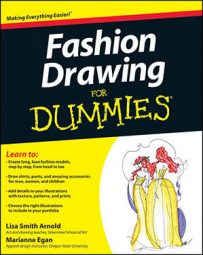Topstitching for function and looks
Topstitching, which is thread stitched on the fabric that can be seen from the outside, can add the detail that distinguishes one pair of pants from another. Topstitching can have both a functional and decorative purpose. When it’s used functionally on a pair of pants, topstitching attaches pockets or a zipper (on a fly front) to the pants or strengthens a seam.When it’s used decoratively, topstitching creates a design on pockets or down a pant leg, adding visual interest to an otherwise plain stretch of fabric. Some pants and shorts have hardly any topstitching, whereas others are full of it.
This is what topstitching looks like:
-
Dashed lines: These individual lines can be any length within reason. The dashes represent the thread used to create the topstitching.
-
Multiple dashed lines: Pants, shorts, and especially jeans often have more than one row of topstitching. You may see topstitching in pairs or in triple rows down the sides or the inseam of the legs due to the type of seam used to construct that area.

Play with the length of the dashed lines, the number of rows of lines you place next to each other, and the color of the dashes to add some pizzazz to your pants.
If you’re drawing with colored pencils or markers, you can add your topstitching in a different color than the color you used to draw the outline of the pants. For example, if you draw a pair of black jeans, add gold or silver topstitching.Don’t limit topstitching to the pockets; imagine all the other places you can use it. Topstitching looks good in the following places:
-
Around the top and bottom of the waistband
-
On the front fly
-
Down the sides
-
Outlining the pockets
-
On the pockets for added detail
-
Around the hem
-
Across the yoke

You also find topstitching on garments other than pants — shoes, shirts, and coats all look a little nicer with topstitching detail.
Add pockets to your fashion pants
Pockets play a key role when you’re drawing pants. Some are easy to see from the outside (usually in jeans), and others are sort of hidden in the side seams (you can’t really illustrate these; just draw a hand hiding in them). Here’s a list of the variety of pocket styles:-
Stitched, rounded pocket: Almost always used as front pockets, these usually appear in pairs, stay flat on the body, and have a row or two of topstitching on the inside edge. The right front pocket on a pair of jeans often includes a little coin pocket peeking out above the opening.
-
Back pocket: Back pockets go on the back of pants, especially jeans. Back pockets feature a flat topstitched pattern of some sort and lay flat on the body.
-
Safari pocket: Safari pockets, which you generally see in men’s pants, have a flap on top, a button or snap closure, folded fabric (or pleats, indicated by the two vertical lines) to give extra room in the pocket, and topstitching around the perimeter to attach the pockets to the pants. They’re not flat, and from the side, the safari pocket looks similar to the cargo pocket. The safari pocket is often found on the side of men’s pants.
-
Cargo pocket: Cargo pockets are popular in men’s pants and have made their way onto women’s pants as well. They feature a rounded fold in the body, a flap with a button or snap (sometimes invisible under the flap), and topstitching around the perimeter. They’re usually located on the sides or back of the pants.
-
Flap pocket: Flap refers to a piece of material that covers the opening on the pocket. A flap can be paired with any type of pocket that doesn’t already include a flap as part of its design, thus creating a flap pocket. Flap pockets usually include a button or snap to keep the flap closed.
-
Side-seam pocket: A side seam pocket is generally invisible from the outside of the garment. It’s visible simply as a slit in the side seam. You may see topstitching around the pocket on the seam line.


